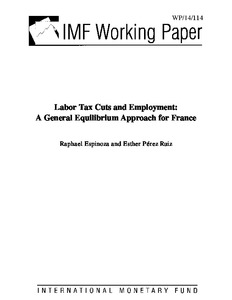Labor tax cuts and employment: a general equilibrium approach for France
"The paper presents a simple supply side, general equilibrium model to estimate the macroeconomic effects of labor tax cuts. The model assumes that output is produced using capital, unskilled and skilled workers, and public servants. Wage formation for skilled workers features a Blanchflower-Os...
| Main Authors: | , |
|---|---|
| Institution: | ETUI-European Trade Union Institute |
| Format: | TEXT |
| Language: | English |
| Published: |
Washington, DC
2014
IMF |
| Subjects: | |
| Online Access: | https://www.labourline.org/KENTIKA-19117830124919350129-Labor-tax-cuts-and-employment-.htm |
| Summary: | "The paper presents a simple supply side, general equilibrium model to estimate the macroeconomic effects of labor tax cuts. The model assumes that output is produced using capital, unskilled and skilled workers, and public servants. Wage formation for skilled workers features a Blanchflower-Oswald wage curve, while the labor supply for unskilled workers is very elastic around the minimum wage for small changes in employment. The model is calibrated for France and used to estimate the output and employment effects induced by two recent tax reforms: the Crédit d’Impôt pour la Compétitivité et l’Emploi (CICE) and the Pacte de Solidarité Responsabilité (RSP). We find that the tax cuts, if not offset by other fiscal measures, would contribute overall to creating around 200,000 jobs in the short run (600,000 jobs in the long run). Since the model abstracts from demand side effects, the results should be interpreted as providing estimates of the effect of tax measures on potential output and potential employment." |
|---|---|
| Physical Description: | 36 p. Digital |

